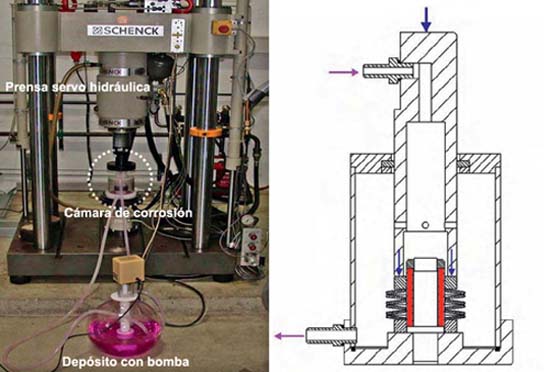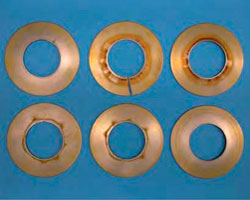CORROSION TESTS WITH FATIGUE
In these test we analyze the belleville washers resistance to corrosion in a dynamic application, which means that is working in fatigue cycles.
Same as trials with tension, pieces are subjected under internal tensions (variable in this case), which accelerate the corrosion process of the pieces. On the other hand when we work in dynamic applications, unlike the previous tests, materials resistance to fatigue is also important as well as their resistance to corrosion to lengthen the disc springs’ useful life.
It is important to emphasize that these tests are exclusively valid in the conditions they have been carried out. For this reason they can be used as a reference. In real applications, there may be different conditions that would change the result. Then, in case you would like to study a real application, we recommend you to contact with our technical department.
Test preparation
To realize the test we prepare belleville washers stacks 6x1 (serial stacks of 6 washers) with different samples in stainless steels and standard steel with anticorrosive coatings. Materials and coatings used ar specified in the tests methodology page..
These stackings are immersed in different corrosive solutions working under fatigue until their breakage.
Equipment used for these tests is composed in 3 parts:
- Servo-Hydraulic Press:Performs the fatigue compression cycles on the pieces. Maximum force 63 KN, maximum travel 100 mm.
- Corrosion chamber: It is where the washer stack is immersed in the corrosive solution.
- Tunk with pump: It contains the corrosive solution and it makes it circulate by pumping it through the corrosion chamber.

The stack is guided internally and without grease. The corrosive solution is pumped, circulating through the pieces in the compression chamber. The pieces are not completely immersed, to avoid the formation of hydrostatic pressures in the inner part of the stack, which could cause additional forces on belleville washers, affecting the test result. All tests are carried out at room temperature.
Two tests are carried out, the first for fatigue cycles between 20% and 80% of the spring compression. The second test is performed for fatigue cycles between 20% and 60% of its compression. In this way we can compare the effect of corrosion in different situations of demand of the disc springs. In both cases, the useful life of the pieces is taken into account until their breakage.
In these tests, the use of 40% magnesium chloride MgCl2 solution was rejected because it was excessively corrosive. The 3% sodium chloride NaCl solution allows us to evaluate the effects of Chloride solutions.
Corrosion test with fatigue 20% - 80%
For this corrosion test, fatigue cycles have been established by working the stacks between 20% and 80% of their travel. The test is carried out at room temperature. The measurement in hours tells us the useful life of the stack before the breakage occurs.
| Variants | Diferent Agresive Solutions | |||
|---|---|---|---|---|
| Spring + Material + Manufacturing Method | Deionized Water | 3% NaCl | 0,1 n NaOH | 0,1 m ácido |
| C-63 - 1.4310 - Stamping - Rectified | 14.171 | 17.952 | 37.767 | 22.280 |
| C-63 - 1.4310 - Stamping - Rectified - Shot Peneed | 18.255 | 20.300 | 38.033 | 25.389 |
| C-63 - 1.4568 - Stamping - Rectified | 12.924 | 17.207 | 32.747 | 19.520 |
| C-63 - 1.4568 - Stamping - Rectified - Shot Peneed | 20.480 | 24.823 | 34.555 | 20.090 |
| C-63 - 1.4568 - Stamping - Rectified - Shot Peneed - Kolsterised | 11.339 | 22.199 | 32.533 | 30.883 |
| 51 CrV4 | ||||
| Yellow Galvanized | 26.839 | 25.510 | 26.477 | 14.058 |
| Transparent Galvanized | 7.841 | 11.323 | 14.509 | 4.318 |
| Dacromet | 5.676 | 4.944 | 6.033 | 4.849 |
| Geomet | 5.428 | 6.159 | 4.517 | 4.031 |
| Delta Tone + Delta Seal | 24.795 | 10.355 | 10.127 | 5.563 |
| Nickel Plating | 7.083 | 6.461 | 12.058 | 6.414 |
| Paint diluted in water | 22.138 | 13.469 | 9.902 | 4.195 |
| Oiled | 13.956 | 5.493 | 19.606 | 5.178 |
- 40% MgCl2: Magnesium Chloride
- 3% NaCl: Sodium Chloride
- 0,1 n NaOH: Sodium Hydroxide
- 0,1 m ácido: Citric acid
- C-63: 63 x 31 x 1,8 (DIN 2093)
- Kolsterised: Treatment that improves austenistic stainless steel resistance to wear.
- Room Temperature
- Fatigue cycles between 20% and 80% of the possible displacement.
Conclusions
- Stainless steel samples show their better behaviour in Sodium Hydroxide conversely it is in deionized water where they had worst performance.
- Deionized water as a medium wouldn’t be able to break, neither chemicaly or electrochemically, the passive oxide layer which is superficially formed in stainless steel pieces. Then it would seem that stainless steel should be resistant in this medium. However in fatigue conditions, the slipping bands formation due to friction destroys this passive oxide layer allowing a quick electrochemical corrosion in the area.
- In case of Sodium Chloride 3% NaCl with stainless steel, Chloride ions break the passive oxide layer allowing electrochemical corrosion in these areas. However, the characteristics of this solution result in less electrochemical corrosion and a higher duration than the previous case.
- Samples immersed in Citric acid (C8H8O7) 0,1M and in Sodium Hydroxid NaOH 0,1N, stainless steel pieces showed a biggest regeneration capacity of their passive oxide, increasing the pieces duration. Being Sodium Hydroxide the one which offers a biggest regeneration capacity to stainless steels.
- Regarding pieces with anticorrosive coatings, they show their best capacity in Sodium Hydroxide due to hydroxide layer 0,1N which appears in the pieces surface protecting them from corrosion.
- In Acid Citric (C8H8O7) 0,1M is where we worst work with springs that have anticorrosive coatings. Zinc layers react with the citric acid. This chemical reaction tend to break the protector layer allowing base material corrosion.
- In the 3% NaCl Sodium Chloride Solution we observed a different behavior, because high conductivity of this solution produces a short life to some coatings, while for others instead, produces the formation of a protector layer due to Chloride which helps to delay the corrosive process and increases the piece life.
In the following images we can see the result of corrosion with fatigue in the sodium chloride solution 3% NaCl. The pieces correspond to stainless steel 1.4310 stacks with shot peened treatment. These photos were taken at the end of the fatigue test.
 |
 |
Corrosion test with fatigue 20%-60%
In this second test, we reduced the stack path. Fatigue cycles are carried out between 20% and 60% of their path. Springs are less demanded. The rest determinants remain unalterable both in corrosive solutions and in room temperature.
Comparing with the previous test, through this one we can see not only the influence of the washers corrosion in dynamic applications but we can see the influence of the material’s fatigue in the life of the stacking.
In this table we can see the results:
| Variants | Diferent Agressive Solutions | |||
|---|---|---|---|---|
| Spring + material + Manufacturing method | Agua Desionizada | 3% NaCl | 0,1 n NaOH | 0,1 m ácido |
| C-63 - 1.4310 - Stamping - Rectified | 19.552 | 21.858 | 30.037 | |
| C-63 - 1.4310 - Stamping - Rectified - Shot Peneed | 33.236 | 40.005 | 51.965 | 47.338 |
| C-63 - 1.4568 - Stamping - Rectified | 12.357 | 17.383 | 34.692 | |
| C-63 - 1.4568 - Stamping - Rectified - Shot Peneed | 21.845 | 27.974 | 41.433 | |
| C-63 - 1.4568 - Stamping - Rectified - Shot Peneed - Kolsterised | 32.933 | 34.000 | 40.250 | |
| 51 CrV4 | ||||
| Yellow galvanized | 103.618 | 292.537 | 73.386 | |
| Transparent galvanized | 153.506 | 295.742 | 1.702.463 | 49.507 |
| Dacromet | 129.507 | 46.388 | 28.192 | |
| Geomet | 141.642 | 59.555 | 24.128 | |
| Delta Tone + Delta Seal | 167.443 | 240.707 | 22.578 | |
| Nickel Plating | 47.429 | 27.854 | 19.208 | |
| Paint diluted in water | 94.033 | 91.741 | 15.703 | |
| Oiled | 106.702 | 32.806 | 1.443.281 | 28.078 |
Results: In No. of cycles
- 40% MgCl2:Magnesium Chloride
- 3% NaCl: Sodium Chloride
- 0,1 n NaOH: Sodium Hydroxide
- 0,1 m ácido: Citric acid
- C-63: 63 x 31 x 1,8 (DIN 2093)
- Kolsterised: Treatment that improves austenistic stainless steel resistance to wear.
- Room Temperatura
- Fatigue Cycles between 20% and 60% of their possible shift.
Conclusions
- Reducing the stacking travel during fatigue cycles, the life of all pieces has increased.
- The increase of cycles in the pieces in standard steel and with anticorrosive coating, has been in general much greater than the one with stainless steel samples.
- The standard steel of disc spring 51CrV4 as a material, has a better resistance to fatigue than the stainless steels 1.4310 and 1.4568. However, treatments such as shot peneed and kolterised, improve the characteristics of these stainless materials against fatigue, improving their performance.
- As in the previous test, the stainless steels suffer an important corrosion in the deionized water and in the solution of NaCl 3%, due to the wear of its passive oxide layer and the strong electrochemical corrosion that occurs in this elements.
- The belleville washers with anticorrosive coatings, offered a good response in deionized water. Even oiled parts exceeded 100,000 cycles.
- In the 3% sodium chloride NaCl solution, the Dacromet and Geomet coatings are clearly affected. This is because these coatings are brittle in this solution, so after a few cycles they start to flake off, boosting the corrosive process.
- Galvanized coatings as well as Delta Tone + Delta seal offers a good result in deionized water and much better in the Sodium Chloride NaCl at 3% due to the oxide layer created by zinc.
- The Citric Acid (C8H8O7) 0,1M is the only corrosive media where stainless steels have had a better result than coatings.
- From all materials and coatings in this test, Galvanized has been the one that has offered a better performance in different medium.
